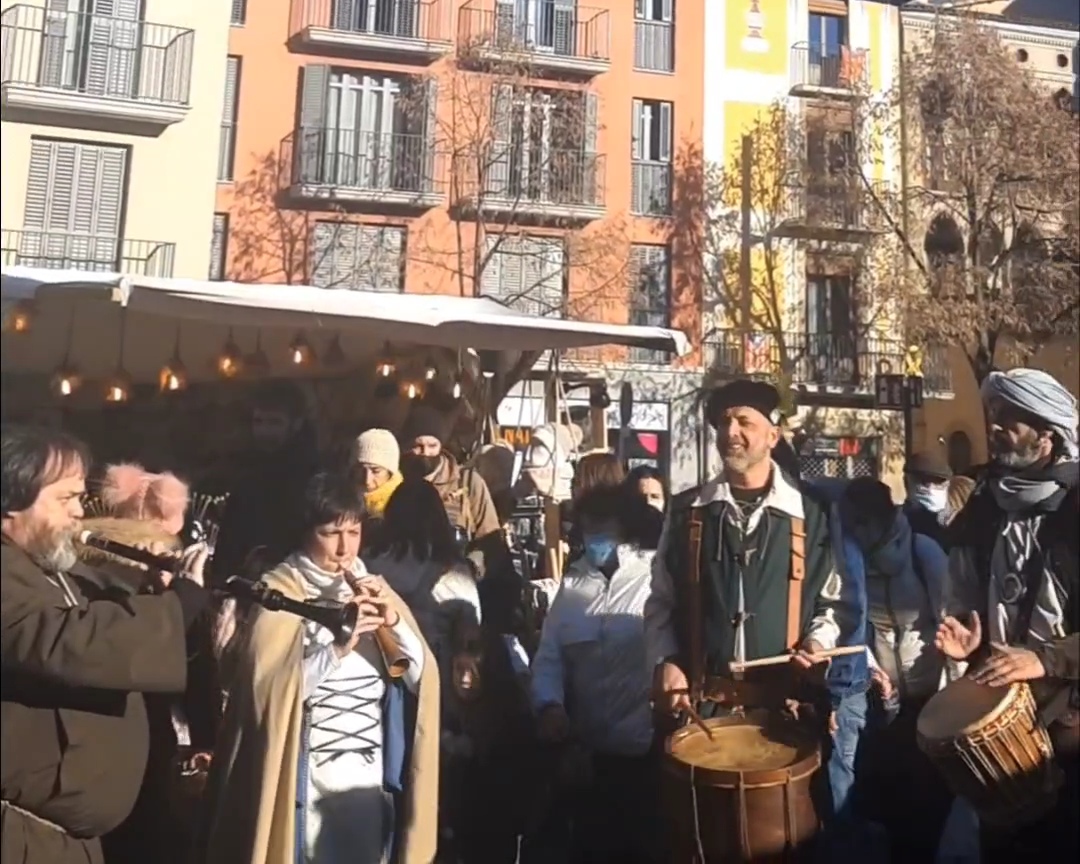Need something to do in Barcelona in December and fancy completely plunging into the deep pool of Catalan culture? Look no further! Hop on the train to Vic for its otherworldly Mercat Medieval and prepare to be whisked away on a sensory journey through time.
Experiencing the Mercat Medieval de Vic
Joining some local friends on an event that I simply “mustn’t miss out on”, I hopped on the train from Barcelona and made my way to the small Catalan city of Vic.
I’d never heard of the city before, so perhaps, quite ignorantly, I had low expectations. Although it’s a small and relatively unheard-of destination for tourists, Vic’s train station was swarming with people wrapped up in their winter clothes and laughing heartily. After a short stroll down the road, I realized what all the fuss was about. We quickly found ourselves in the Plaça Major de Vic, the largest square in Catalonia, lined with ornate architecture and archways leading to cozy cafes. Bizarrely, the centre of the square is filled with sand, and when I asked the locals, they explained that this unique feature is rooted in the city’s long history. Events like Correbous (bull runs), performances, races, and markets have taken place here since before the Middle Ages, and the sandy floor is still maintained out of tradition.
Spilling out from the square and curving down many side streets were hundreds of market stalls that make up the Mercat Medieval de Vic. Row after row of stalls sold traditional Catalan crafts, medieval artifacts, and themed beverages and food. The strong smells of herbs and spices flooded our senses, and we followed the crowd to sample what we fancied.
Market Stalls and Food Delights
Many of the stalls had barrels – and I mean barrels – of steamy mulled wine on offer. After trying a couple we decided on a particularly aromatic one. The bartender poured us each a large cup, and as I drank, I felt it burn my throat from the strong alcohol content. I had forgotten how potent the drinks are in this part of the world!
Needing food to line my stomach, we wound down side streets filled with dozens of carts and stalls selling strips of gourmet pork, cured sausages, in particular Fuets (a traditional Catalonian thin and dry-cured sausage seasoned with salt, white wine, white pepper, and fresh garlic) and llonganissas (another traditional Catalan pork sausage but longer than a Fuet with red pepper and a sweet and garlicky flavour). As a vegetarian, I worried about finding a meat-free option. Fortunately, we found a large food and beverages area, offering plenty of crepes, artisan pastries, and other delicious choices. Despite being a medieval themed festival there were options for everyone with various dietary requirements.
Festival Highlights
We found a table under a canopy of embroidered flags by the river and watched the world around us. We saw a gin vendor claiming to have recreated ancient liquors of all different colours and flavours, tapestry making stalls with ink-stained tables and many people dressed in all sorts of medieval clothing from knights to nobles and their servants. A key part of the festival features a reenactment of ‘The Assault of the Altarriba’, a historic tale from fifteenth-century Vic. More than 40 actors participate in this reenactment across multiple emblematic settings in the city. We missed this however saw many other short shows with actors and vendors dressed in traditional medieval Catalan wear.
I would have to say, besides the food and the scenery, the highlight of the event is the music. Small bands filled nearly every street corner, playing large drums and traditional instruments. Their upbeat folk music perfectly complemented the ambiance of the medieval market.
Historical Sites of Vic
Vic itself is scattered with ancient sites. The looming Cathedral of Vic, with its original Romanesque bell tower and crypt, dates back to the 11th century. The rest of the cathedral is a blend of styles from various centuries. You’ll also find a proud Roman temple from the 2nd century and the Pont de Queralt, an 11th-century stone bridge that reflects Vic’s medieval importance.
The Verdict
Vic’s Mercat Medieval is truly unique, unlike anything I’ve experienced before. The festival lasts five days and you can enjoy competitions, shows, performances, archery classes, and activities for children. If you’re in Barcelona this December, don’t miss the Mercat Medieval de Vic, where history, culture, and flavor intertwine for an unforgettable experience!
How to Get There from Barcelona:
Take the R3 train from Barcelona to Vic, which takes approximately 1 hour and 15 minutes. You can catch frequent trains, especially during the festival period, and buy tickets either at the station or online.
Other Useful Information:
Dates: The Mercat Medieval de Vic typically takes place in early December. It’s held to coincide with the Pont de la Puríssima (a public holiday on the 6th and 8th of December).
Entry: Free to enter, but some performances or activities may require tickets.
Languages: People in Vic mostly speak Catalan and Spanish, but you’ll also hear English frequently.
One response to “Mercat Medieval de Vic: A Must-Visit Medieval Festival in Catalonia”
-
[…] For the next few months only, Japan House London is offering a unique exhibition that provides a deep insight into Japanese culinary culture. Their free exhibition ‘Looks Delicious!’, is definitely not one to miss if you’re a foodie with an open mind and a penchant for trying something new. […]



[…] For the next few months only, Japan House London is offering a unique exhibition that provides a deep insight into Japanese culinary culture. Their free exhibition ‘Looks Delicious!’, is definitely not one to miss if you’re a foodie with an open mind and a penchant for trying something new. […]